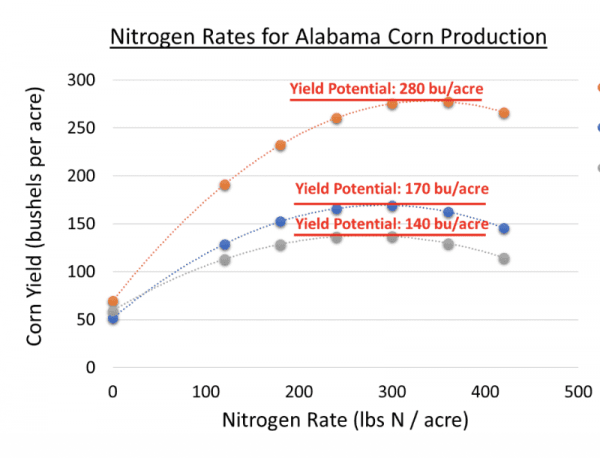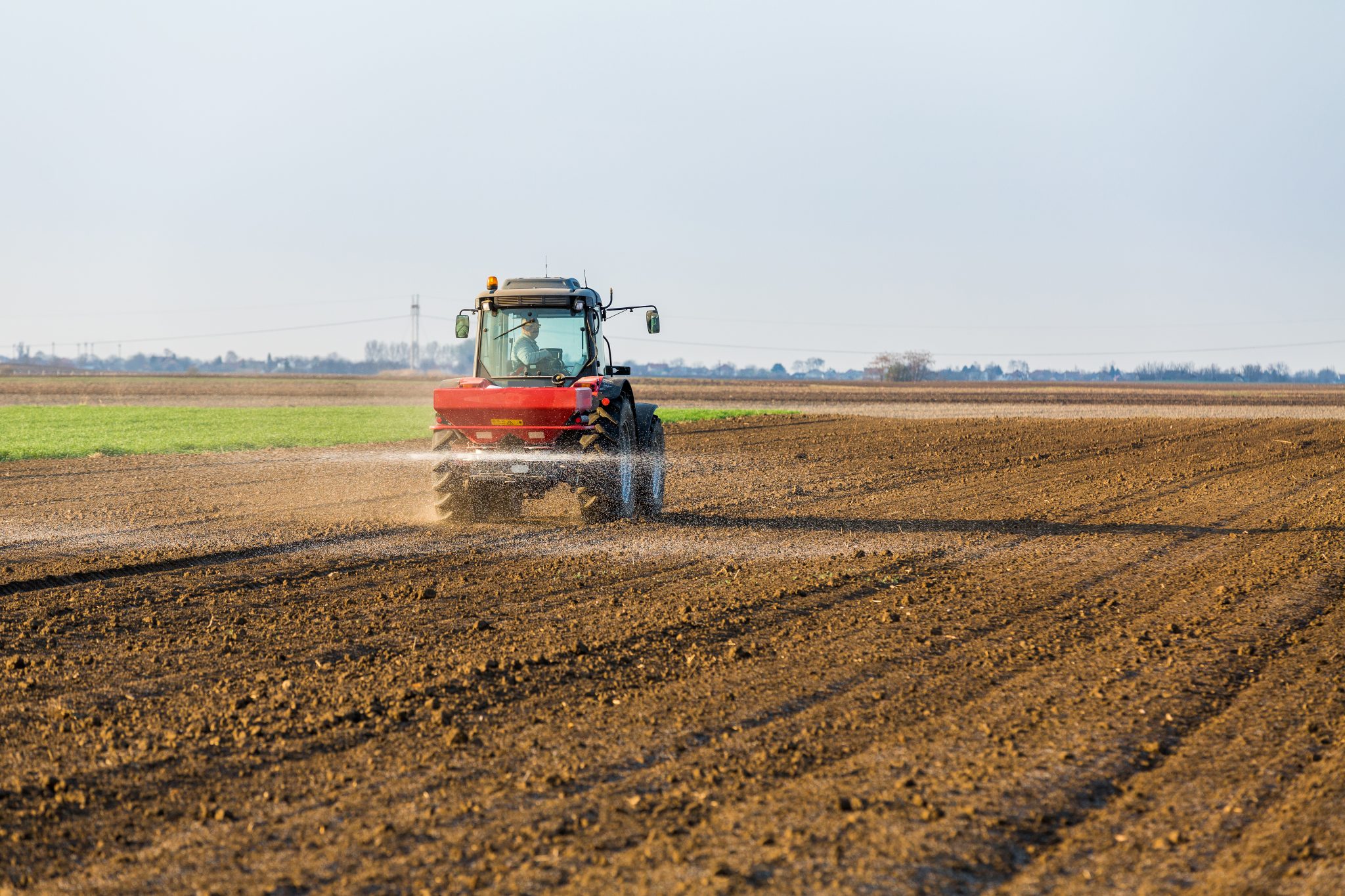Farming

Alabama row crop producers face a bleak market outlook for the 2020 growing season. In times of economic uncertainty, producers must manage inputs efficiently. The points below offer considerations for managing fertilizer input costs to maximize profitability.
Use Research-Based Soil Test Recommendations
Decades of research have been used to correlate soil-extractable nutrients with increases in yield to develop fertilizer recommendations for Alabama crops. In Alabama, this research has been based on yield increases according to Mehlich1-extractable soil nutrients (except in the Blackbelt region where the Mississippi extract is used). Soil test reports from the Auburn University Soil, Forage, and Water Testing Laboratory use formulas to calculate the recommended phosphorus (P) and potassium (K) to the nearest 10 to 30 pounds. Auburn recommendations continue to be evaluated for newer, higher-yielding row crop varieties.
While public labs use research-based information to update soil test recommendations, there is no guarantee that fertilizer recommendations from private, commercial laboratories are based on local research. Commercial laboratories may recommend more fertilizer than is required to maximize economic return. However, it is possible to generate fertilizer recommendations based on Auburn University research as long as the appropriate soil extractant (Mehlich1 for most Alabama soils) is used. To convert results from private soil testing laboratories to Auburn recommendations, use the Alabama Soil Test Recommendation Tool or contact your regional Extension agent.
Use a Soil Sampling Strategy that Accounts for Field Variability
Soil acidity and nutrient content can vary widely throughout a field. Traditional soil sampling techniques rely on random sampling throughout a field followed by a uniform application of fertilizer according to average recommendations for that field. Precision technologies increase our ability to (1) apply fertilizer and lime where we need it the most and (2) avoid applying fertilizer and lime where soil test levels are sufficient.
Zone Sampling: This sampling technique allows producers to divide the field into management zones based on knowledge of a specific field. One method for creating zones is to divide a field according to soil type. Soil type information for a specific field can be obtained from the USDA Natural Resources Conservation Service (NRCS) Web Soil Survey.
Another method is to divide a field into according to yield potential based on information from yield maps or farmer knowledge of the field.
Grid Sampling: This soil sampling technique is widely used to assess field variability in Alabama soils. In this method, fields are divided into uniformly spaced rectangles and sampled accordingly. The most common grid size used in the state is a 2.5-acre grid.
Producers can work with their local ag retailers to create a map for precision application of nutrients according to soil sampling results for zones or grids.
Be Realistic about Your Yield Goals
For some nutrients, fertilizer recommendations vary by yield goal. For example, nitrogen recommendations for corn will vary according to the anticipated yield. When determining a yield goal, it is important to ask the question, At what fertilizer rate can I maximize profitability? instead of focusing on, At what fertilizer rate can I maximize yield? The figure below shows corn yield according to the nitrogen rate for three Alabama soil types. For the Decatur silt loam production system, profitability was maximized at 360 pounds N per acre. For the Dothan sandy loam production system, profitability was maximized at 180 pounds N per acre. The most profitable fertilizer rate was not necessarily the rate at which the yield was maximized. Be realistic about yield potential in a given field to determine fertilizer rates and maximize economic potential.


N Source: 34-0-0
Split-applied: One-third at plant and two-thirds at V6.
Irrigation: All plots irrigated through center pivot.
Compare Nutrient Rates in Fertilizer Products
When comparing prices of fertilizer prices, it is important to consider the concentration of nutrient within a product. For example, nitrogen fertilizers are often compared based on price per unit of N instead of price per ton of product. While this may seem obvious for macronutrients such as nitrogen, price per unit of nutrient is often overlooked for less frequently applied nutrients, such as calcium and boron. The example in the table compares calcium concentration for various fertilizer products commonly applied for peanut production. Some alternative sources of calcium supply less calcium at a higher price. Unless there is documented research that the source of fertilizer impacts nutrient uptake or nutrient loss, select a product that is the most cost-effective per unit of nutrient.
Compare Nutrient Rates in Fertilizer Products
| Product | % Ca | Product info | Product Rate lbs per acre | Ca Rate lbs per acre |
|---|---|---|---|---|
| Gypsum | 21% | CaSO4 | 1000 | 210 |
| Hi-Cal Lime | 34% | CaCO3 | 1000 | 340 |
| Alternative Gypsum 1 | 12% | Humate - 21% | 1000 | 120 |
| Alternative Gypsum 2 | 11% | Mg - 1%, B - 0.02%, Co - 0.0005%, Fe - 1% | 1000 | 110 |
| Liquid Ca 1 | 12.5% | Humate - 1% liquid | 3 (gal/acre) | 4 |
Make pH a Priority
Maintaining soil pH is the first step to improving soil fertility for crop production. Most Alabama soils are naturally low in pH and must be limed to create soil conditions that boost production. When the pH of soil falls below a value of 6.0, the availability of most macronutrients needed for crop production (such as nitrogen and phosphorous) decreases. However, the availability of most plant micronutrients (such as zinc, manganese, and iron) increases at low pH. Maintaining pH according to soil testing lab recommendations will ensure that the availability of all plant nutrients is maximized so that any fertilizers applied to the soil do not go to waste. Maintenance of soil pH is money well-spent for producers because it improves crop quality and yield.
Implement a Plant Tissue Sampling Program
Tissue testing is used to ensure that adequate nutrients are present for crop growth. Tissue testing can be used to (1) diagnose a nutrient deficiency symptom or (2) monitor crop nutrient status throughout the growing season.
Diagnostic testing: If a nutrient deficiency is suspected, plant tissue should be sampled from the area of the field where deficiencies are suspected and an area where crop growth is adequate. Soil samples should also be collected from the “poor growth area” and the “adequate growth area” to accompany
Monitoring of plant nutrient status: Tissue samples can be collected throughout the growing season to monitor crop nutrient status. Use the information gained from tissue testing to adjust fertilizer applications. For consistent tissue testing results, collect samples at the same time of day for each sampling date.
For a representative tissue sample, collect leaves from 25 to 30 randomly selected plants within the sampling locations. For young seedlings, collect whole plant samples (clip the plant approximately 1 inch above the soil level) for 25 to 30 plants. For larger plants, collect the most recent fully expanded or mature leaf for 25 to 30 plants. Place samples in a paper bag to send for analysis at your soil testing lab.

